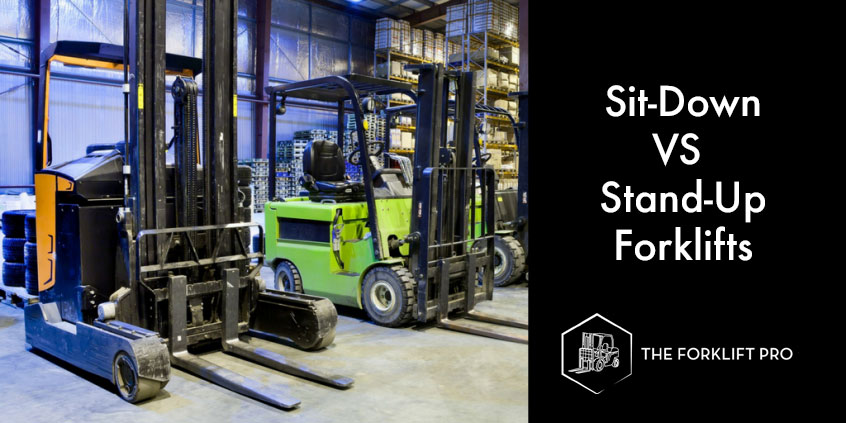Though the end goal for all forklift types is to safely and efficiently move product, each forklift type varies greatly. Determining the best forklift for your application is not only going to save you time and money, but the decision will also benefit your operations from a safety standpoint.
Counterbalanced forklifts come in two main types – sit-down and stand-up models. To review, a counterbalanced lift truck is designed to lifts loads and transport product by counterbalancing the weight of the load with cast iron, or the battery located in the back of the truck. They are considered one of the more popular forklift types for indoor warehouse operations.
Main differences between sit-down and stand-up forklifts
Sit-down forklifts come in 3-wheel and 4-wheel models, depending on your specific needs. A 3-wheel forklift is the more suitable choice for navigating smaller spaces due to their ability to increase maneuverability. Typically a sit-down forklift is optimal for the forklift operator that doesn’t have to leave the driver’s seat to move product. A sit-down model provides more comfort if a forklift driver has to operate a forklift for extended periods of time.
Not all operations allow for the use of a sit-down model due to space limitations and workload requirements. Stand-up forklifts are space savers and can operate more efficiently in smaller spaces. The turning radius is improved due to the compact nature of the truck. Stand-up forklifts also provide improved visibility for the driver, as opposed to a sit-down model that only allows for front-facing visibility.
How to determine which forklift suits your material handling needs
Your trusted forklift wholesaler can help you choose the best machine for your specific application, whether you are picking piece-by-piece inventory or moving pallets with heavy product. Here are some examples of common questions used to guide dealers to choose the right forklifts:
- How far of a distance will the forklift operator travel at one time? Will they have to frequently get on and off of the machine?
- How much space will the forklift operator have available to navigate the machine? Will they be maneuvering through narrow aisles or sharp corners?
- Will the forklift be used for extended periods of time throughout the day?
- What is the floor type?
- Which accessories and attachments will be used?
- What is the nature of the product being moved?
Driver comfort is key
Constant body twisting to increase visibility on a forklift can cause ergonomic issues and discomfort for the operator. Driver fatigue from constant standing can also be a hazard. These two factors are crucial components in making the right MHE choices for your material handling objectives.
Training for sit-down and stand-up forklifts
Though counterbalanced sit-down and stand-up forklifts are both considered Class 1 Warehouse forklifts, both models require specific training. There is a lot of variation in speed capability, maneuverability, load handling, and general operation. Keep your facility OSHA-approved by ensuring your forklift drivers have the proper certifications for any forklift type used in your day-to-day operations.
Let The Forklift Pro Help
As you know by now, not all forklifts are the same. There are too many risks associated with guessing which types of MHE you need. The Forklift Pro sales team is experienced in helping dealers decide which pieces of MHE will be most beneficial to their customers. Let’s discuss how to get the best forklifts for the job in your inventory and into your customers’ facilities today.

